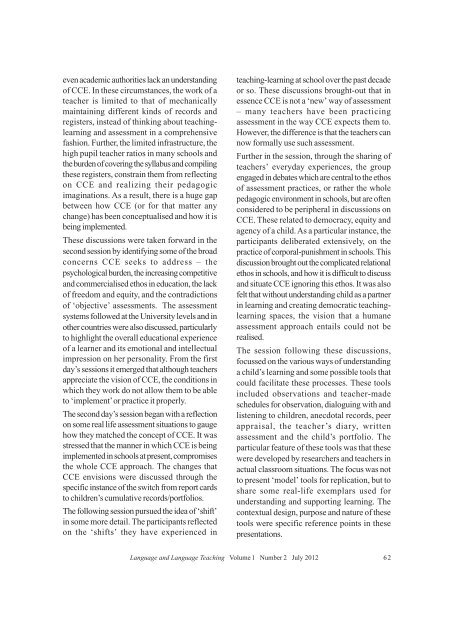Language and Language Teaching, Issue 2 - Azim Premji Foundation
Language and Language Teaching, Issue 2 - Azim Premji Foundation
Language and Language Teaching, Issue 2 - Azim Premji Foundation
Create successful ePaper yourself
Turn your PDF publications into a flip-book with our unique Google optimized e-Paper software.
even academic authorities lack an underst<strong>and</strong>ingof CCE. In these circumstances, the work of ateacher is limited to that of mechanicallymaintaining different kinds of records <strong>and</strong>registers, instead of thinking about teachinglearning<strong>and</strong> assessment in a comprehensivefashion. Further, the limited infrastructure, thehigh pupil teacher ratios in many schools <strong>and</strong>the burden of covering the syllabus <strong>and</strong> compilingthese registers, constrain them from reflectingon CCE <strong>and</strong> realizing their pedagogicimaginations. As a result, there is a huge gapbetween how CCE (or for that matter anychange) has been conceptualised <strong>and</strong> how it isbeing implemented.These discussions were taken forward in thesecond session by identifying some of the broadconcerns CCE seeks to address – thepsychological burden, the increasing competitive<strong>and</strong> commercialised ethos in education, the lackof freedom <strong>and</strong> equity, <strong>and</strong> the contradictionsof ‘objective’ assessments. The assessmentsystems followed at the University levels <strong>and</strong> inother countries were also discussed, particularlyto highlight the overall educational experienceof a learner <strong>and</strong> its emotional <strong>and</strong> intellectualimpression on her personality. From the firstday’s sessions it emerged that although teachersappreciate the vision of CCE, the conditions inwhich they work do not allow them to be ableto ‘implement’ or practice it properly.The second day’s session began with a reflectionon some real life assessment situations to gaugehow they matched the concept of CCE. It wasstressed that the manner in which CCE is beingimplemented in schools at present, compromisesthe whole CCE approach. The changes thatCCE envisions were discussed through thespecific instance of the switch from report cardsto children’s cumulative records/portfolios.The following session pursued the idea of ‘shift’in some more detail. The participants reflectedon the ‘shifts’ they have experienced inteaching-learning at school over the past decadeor so. These discussions brought-out that inessence CCE is not a ‘new’ way of assessment– many teachers have been practicingassessment in the way CCE expects them to.However, the difference is that the teachers cannow formally use such assessment.Further in the session, through the sharing ofteachers’ everyday experiences, the groupengaged in debates which are central to the ethosof assessment practices, or rather the wholepedagogic environment in schools, but are oftenconsidered to be peripheral in discussions onCCE. These related to democracy, equity <strong>and</strong>agency of a child. As a particular instance, theparticipants deliberated extensively, on thepractice of corporal-punishment in schools. Thisdiscussion brought out the complicated relationalethos in schools, <strong>and</strong> how it is difficult to discuss<strong>and</strong> situate CCE ignoring this ethos. It was alsofelt that without underst<strong>and</strong>ing child as a partnerin learning <strong>and</strong> creating democratic teachinglearningspaces, the vision that a humaneassessment approach entails could not berealised.The session following these discussions,focussed on the various ways of underst<strong>and</strong>inga child’s learning <strong>and</strong> some possible tools thatcould facilitate these processes. These toolsincluded observations <strong>and</strong> teacher-madeschedules for observation, dialoguing with <strong>and</strong>listening to children, anecdotal records, peerappraisal, the teacher’s diary, writtenassessment <strong>and</strong> the child’s portfolio. Theparticular feature of these tools was that thesewere developed by researchers <strong>and</strong> teachers inactual classroom situations. The focus was notto present ‘model’ tools for replication, but toshare some real-life exemplars used forunderst<strong>and</strong>ing <strong>and</strong> supporting learning. Thecontextual design, purpose <strong>and</strong> nature of thesetools were specific reference points in thesepresentations.<strong>Language</strong> <strong>and</strong> <strong>Language</strong> <strong>Teaching</strong> Volume 1 Number 2 July 2012 62
















